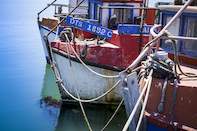Plummeting Fish Numbers
There is considerable debate about what really underlies the dwindling fisheries of the West Coast of South Africa. It could be the inevitable consequence of increasingly high-tech fishing methods, ending in chronic over-extraction of fish.

Already 18 line fish species have collapsed under the pressure of over-harvesting, according to the 2006 State of the Environment Report, while another four are regarded as over-exploited. Or the plummeting fish numbers on the West could simply be a natural and little-understood cycle.
But rising temperatures could also be responsible for pushing them south and east. As more and more certainty emerges from the scientific community about the pressure which rising temperatures are placing on the natural environment, a growing consensus is emerging that global warming could be underlying this “regime shift” in the Benguela Current, where the former dominance of anchovies and sardines has given way to other less commercially important species.
Hot and Cold Changes
Other subtle changes are being picked up in the Benguela. Its far edges, the northern and southern “boundaries” of the current, are warming noticeable, the Benguela Current Large Marine Ecosystem Programme (BCLMEP) scientists reported in 2007, but in some southern parts, the current is cooling a bit.
This has increased the temperature gradients in places. Just as the apparent trekking of quiver trees towards the Cape tells us that the western desert is insinuating itself further south, so the creatures that live in or off the Benguela Current are giving their own whispered clues. The perpetually moving and swirling body of water that we call the Benguela system is also shifting south, and heading east as it rounds Cape Point and following the course laid out for it by the coastline.
By Leonie Joubert